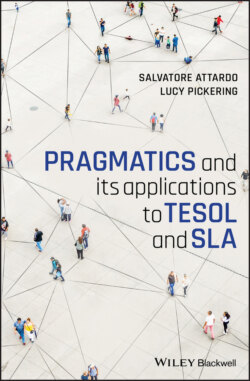Читать книгу Pragmatics and its Applications to TESOL and SLA - Salvatore Attardo - Страница 11
1.1.1 Semiotics
ОглавлениеA sign is the union of a signifier and a signified. The signifier is the mental representation of the physical component of the sign, such as a sound, an image, or an alphabetic symbol. The sequence of phonemes /kæt/, the graphemes “cat,” and Figure 1.1 are all possible signifiers of the sign “cat.”
Figure 1.1 Image of a cat.
The signified is the mental representation of the entity referred to by the sign. When a speaker of English hears the sounds of the word /kæt/ or reads the letters “cat” or sees Figure 1.1, he/she thinks of a cat (has a mental representation, a concept). That thought is the meaning of the word “cat.”
Figure 1.2 A sign is the union of a signifier and a signified.
So, in a sense, a sign is a tool to connect, via two mental representations, two physical world entities: a group of sounds, that is, the actual pronunciation of a group of phonemes and an actual physical object in the world, the referent (namely, an actual cat, with fur, a tail, whiskers, claws, who has been spayed, goes to the vet on Thursday, etc.). There is no easy way to connect the two without going through a conventional pairing of mental representations (of sounds, graphemes, etc. on the one side, and of referents, on the other). If we put all of this into a graphic representation, we get the so-called semiotic triangle, as shown in Figure 1.2. Note how there is no direct link between the sounds and the referent. The job of the sign is to connect the two (sounds and referents).
Figure 1.3 The indirect relationship between the sounds and the referent, mediated by the sign.
There is no reason, except social convention, for a cat to be called a cat or a dog a dog. Consider the fact that a dog is called “dog” in English, “chien” in French, “perro” in Spanish, and “gǒu” in Chinese. If there were a good reason for a dog to be called a dog, then that reason would hold also in China and France. Since it obviously doesn’t, given the variety of terms just considered, then there isn’t one. This is known as the principle of the arbitrariness of the sign.
There are exceptions: iconic signs have a connection with their referent – an arrow points in the direction you want to indicate; the line of a chart goes up in proportion to the increase of the quantity you are symbolizing. Onomatopoetic signs sound like the thing they refer to, for example, “bang,” “crash,” “hiss.” These exceptions are limited and do not affect the principle of arbitrariness of the sign.
Generally speaking, signs are conventional: they exist only due to a social convention. Think of money: a dollar bill is just a piece of paper; it is not intrinsically valuable, like, say, gold or a car. The dollar bill is worth something only because we have a convention in our society that anyone will exchange that piece of paper for goods of some kind. When we say that it is a convention, we don’t mean to diminish it. Clearly society invests large amount of resources and time to protect this convention: only the state is allowed to print money and if you try to do it on your own, the police will pay you a visit very soon.
A language is then a system of signs. The examples we have used so far, for simplicity, have all been lexical items, but grammatical constructions, word order, intonation, and so on are all signs, which are part of the system. A system of signs is also called a code. Think of the Morse code, which was used in the telegraph, in which to each letter of the alphabet correspond some combination of dashes and dots (Figure 1.4). This system is a code in the sense that to each letter we assign, by convention, a sequence of dashes and dots. Note that just like there was no reason for a cat to be called a cat, there is no reason for the letter A to be “dot-dash,” it could just as well have been “dash-dot” (which happens to be the letter N).
Figure 1.4 The Morse code.
